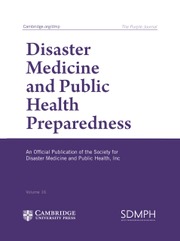Dear Editor,
We read with great interest the recent article by Li et al., which presents the WHO’s evidence-based guideline on the assessment and management of internal contamination with transuranic actinides.Reference Li, Kenbayeva and Dainiak1 This guideline marks an important step forward in radiation emergency medicine, as it applies the GRADE® framework systematically to an area that is often under-addressed in both clinical and public health practice.
Unlike previous narrative reviewsReference Li, Alves dos Reis and Ansari2 that focused on historical response efforts, this guideline—developed with input from international experts across multiple disciplines—addresses 4 specific PICO questions, synthesizes human and animal data, and provides graded recommendations covering assessment techniques, treatment effectiveness, and health outcomes. Notably, it is the first guideline to formally consider outcomes such as myelosuppression, pulmonary fibrosis, trace element depletion, and mental health sequelae within a structured recommendation framework.
The inclusion of nasal swab bioassay as a screening tool for early detection, supported by Guilmette et al.,Reference Guilmette, Bertelli and Miller3 aligns with PICO 1’s emphasis on rapid assessment. Implementing this approach in real-world emergency settings, particularly where laboratory resources are limited, will require not only appropriate equipment but also training for field personnel in swab collection, contamination control, and data interpretation.
Case reports, such as the plutonium puncture wound at Los Alamos described by Klumpp et al.,Reference Klumpp, Bertelli and Dumit4 illustrate the benefits of early chelation therapy and continuous internal dose monitoring. These examples demonstrate that even in low-dose exposures, prompt DTPA administration combined with careful follow-up can substantially reduce systemic radionuclide retention.
We also appreciate the guideline’s consistency with ICRP Publication 1505 regarding organ-specific cancer risks from internal alpha-emitting radionuclides. Prioritizing lung, liver, and bone cancer alongside general mortality reflects both radiobiological evidence and epidemiological findings from exposed populations.
The authors further highlight limitations in global preparedness, especially in low- and middle-income countries. Although Ca-DTPA and Zn-DTPA are recommended for national stockpiles, practical implementation depends on supply chains, drug registration, and cold-chain storage. In Southeast Asia, adapting these guidelines effectively will require regional coordination, centralized procurement, and scalable training programs for frontline responders.
We support the guideline’s recommendation to integrate mental health considerations into radiation emergency protocols. Even when biological exposure is minimal, perceived contamination and uncertainty can trigger acute stress and long-term psychosocial effects. Addressing these outcomes alongside medical interventions is crucial for comprehensive patient care.
In conclusion, Li et al.’s 2025 guidelineReference Li, Kenbayeva and Dainiak1 offers a rigorous and methodologically sound contribution to radiation emergency medicine. We encourage WHO and partner organizations to pilot context-specific implementation studies, particularly in resource-constrained settings, to generate data on feasibility, acceptability, and effectiveness that can support more equitable global preparedness.
Funding statement
The authors received no financial support for the research, authorship, or publication of this article.
Competing interests
The authors declare none.

